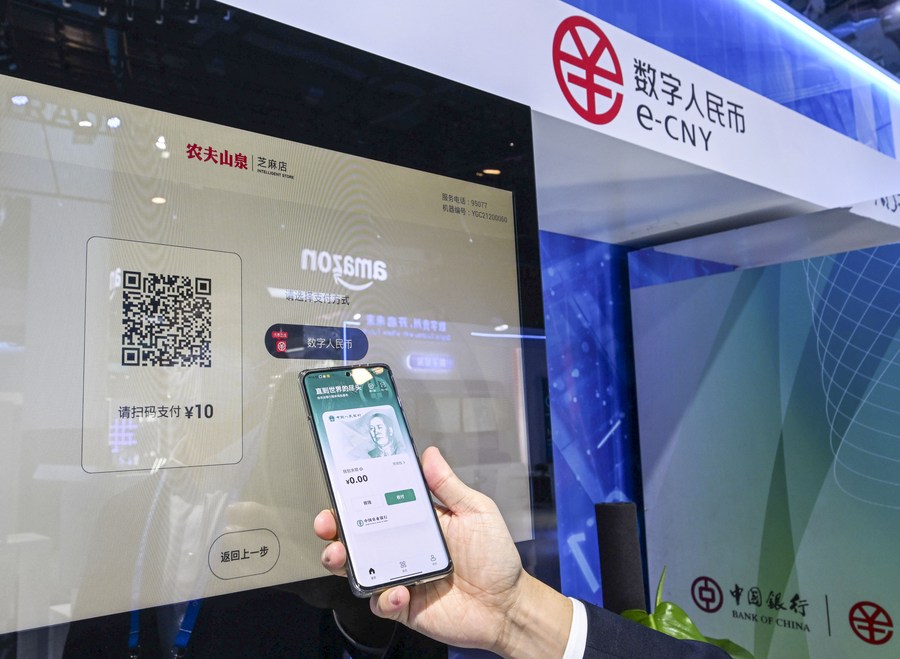How Can China Take Its Digital Economy to New Heights?

The deep integration of the digital and real economies has long been a goal for China. The development of China’s digital economy goes hand in hand with that of the country’s digital infrastructure.
When shopping at a local food market in Bazhong City of Sichuan Province on January 18, Dylan Austin Walker, a young American who was in the area visiting his girlfriend’s family to ring in the Chinese New Year—on January 22 this year, could simply whip out his digital wallet to pay for groceries even in this remote area of the Chinese mainland. “Mobile payment is used widely in China by young and old, in big and small cities—even in villages,” Walker told Beijing Review.
Tobias Bauer, a young German and a partner at Blockchain Founders Fund, an early-stage venture capital firm, echoed Walker’s remarks. For example, when Bauer was living in China in 2017 and 2018, he found that almost nothing was based on cash anymore. Transactions generally went through Alipay, e-commerce giant Alibaba’s payment app, and Weixin Pay, referred to as WeChat Pay in overseas markets, a digital wallet connected to the eponymous app.
As of late 2022, Weixin, or the Chinese version of WeChat, had 811 million monthly active users in China, accounting for 57.9 percent of the total population, according to Statista.com. They use the app to communicate with friends and colleagues, create group chats, order food and play mobile games. “Effectively, your whole life is captured in one app,” Bauer said at a webinar discussing the digital economy on January 18. The webinar was supported by THINC, a 12-month fellowship program established by China’s tech giant Tencent, also the architect of Weixin, and the Beijing-based non-profit foundation Viva la Vida. The program gathers a community of carefully selected young global leaders, Bauer being one of them, to conduct open dialogue on a range of topics related to tech and humanity.
The digital economy is the economic activity that results from billions of everyday online connections among people, businesses, devices, data and processes, according to Deloitte, a global professional services firm that offers auditing, consulting, advisory and tax services.
Mobile payment is a prime example of China’s digital economy, Liu Yangsheng, a senior fellow with the Taihe Institute, a public policy think tank based in Beijing, said during the webinar. He also commended the large scale of the country’s digital economy market.

Major growth engine
Ranking second worldwide for many years only after the United States, China’s digital economy has become a major growth engine for the country, according to a white paper titled Jointly Build a Community With a Shared Future in Cyberspace released by China’s State Council Information Office on November 7, 2022. By 2021, its value had reached 45.5 trillion yuan ($6.3 trillion), accounting for 39.8 percent of the country’s GDP, the white paper read.
It will be worth over 60 trillion yuan ($8.84 trillion) by 2025, according to estimates from the China Academy of Information and Communications Technology, a government think tank.
The digital economy has become a new, higher economic form after the agricultural and industrial economies and is becoming a new commanding asset in global competition, Ouyang Rihui, Assistant Dean at the China Center for Internet Economy Research under Central University of Finance and Economics in Beijing, wrote in an article for Governance, a Chinese weekly, in June 2020.
Also, “the digital economy is a booster and a significant component of modernization of the present stage,” Bai Ming, Deputy Director of the International Market Research Institute at the Chinese Academy of International Trade and Economic Cooperation under the Ministry of Commerce, told Beijing Review. It has become a major way of promoting high-quality development.
China has been highly focused on its digital economic development and to streamline the process and seize more growth opportunities, it has implemented national cyber development and big data strategies. It has also issued a series of policies to better regulate e-commerce and create smart cities.
The country’s first five-year plan on the digital economy, unveiled in January 2022, highlighted the sector’s role in reshaping the global economic structure and international competition, and rolled out targets for its development through 2025. The document laid out measures for upgrading national infrastructure, bolstering the role of data as an important factor of production and promoting the digital transformation of industries.
The four traditional categories in economics are usually termed as land, labor, capital and entrepreneurship. By 2025, the added value of core digital economy industries is expected to account for 10 percent of the country’s GDP, up from 7.8 percent in 2020, the document read.

An integrated process
The deep integration of the digital and real economies has long been a goal for China. “In pursuing economic growth, we must continue to focus on the real economy… We will accelerate the development of the digital economy, further integrate it with the real economy, and build internationally competitive digital industry clusters,” according to the report delivered by Xi Jinping, General Secretary of the Communist Party of China (CPC) Central Committee, to the 20th CPC National Congress on October 16, 2022.
“The two are not paradoxical and, in my opinion, the real economy covers the digital one,” Bai said. For example, online ride-hailing services are a real industry, he explained, adding, “We must not mistake the digital economy for a virtual one.”
“Simply put, we should further focus on the process of industrial digitization and digital industrialization, which are important ways of real-digital integration,” Bai added.
On the one hand, a host of new digital methods have been introduced to upgrade traditional and existing industries. The white paper said the digital transformation of China’s manufacturing industry continues; 55.3 percent of the key processes of large industrial enterprises had become digitally controlled and the application of digital research and development tools was as high as 74.7 percent by February 2022. China’s digital transformation of its agriculture is making steady progress. For example, 5G, the Internet of Things (IoT), big data and artificial intelligence (AI) have all been applied in agricultural production and management. Moreover, online medical services, online education and working remotely have accelerated the digitalization of the service industry.
On the other hand, the data-driven digital economy is also cultivating different emerging industries; for example, e-commerce is flourishing. According to a report released by the Ministry of Commerce, China’s total e-commerce transaction volume hit 42.3 trillion yuan ($6.15 trillion) in 2021, and online channels accounted for 24.5 percent of total retail sales of consumer goods. China has been the world’s largest online retail market for nine consecutive years.

Digital, fundamental
The development of China’s digital economy goes hand in hand with that of the country’s digital infrastructure. Liu said the latter is probably more advanced than all of its peers worldwide. For example, the most technologically progressive 5G system is in China: 5G is no longer just about telecommunications, but has already been incorporated in transportation, into industrial systems.
By June 2022, China had 1.05 billion Internet users and the Internet penetration rate had reached 74.4 percent, the white paper read, adding the country hosted the world’s largest 5G network and had become one of the global leaders in 5G standards and technology, with 1.85 million 5G cell towers and 455 million 5G mobile subscriptions.
“Digital technology covers a wide range, for example, AI and big data,” Lyu Pengyue, a senior partner with ZGC (short for Zhongguancun, a technology hub in Beijing’s Haidian District) Industry Institute, told Beijing Review, adding how “one advantage of China is that we have plenty of application scenarios for digital transformation.”
“We hold advantages in some digital technology, but still need to bridge the gap in some other sectors,” Lyu said. For example, there’s plenty of room for growth in the fields of industrial software and data processing capacity.
“China has made marked achievements in scientific research as the country has built different national key laboratories to boost its scientific research levels; take the excellent solutions in data safety, for instance,” she added.
“However, our commercialization of technological achievements is relatively slow,” Lyu continued. She suggested a better alignment of the communication between key laboratories and industry sectors might prove useful.

Global vision
The growing digital economy and a globally accelerating digital transformation have become important factors affecting the world’s economic landscape. China has highlighted the necessity to expand international cooperation and bring the benefits of the digital economy to the people of all countries.
The Digital Silk Road is an important part of the China-proposed Belt and Road Initiative, which aims to boost connectivity along and beyond the ancient Silk Road routes. Helping Belt and Road participating countries to bridge the digital divide through infrastructure construction and the digitalization of traditional infrastructure is one example in this major undertaking.
“China’s tech investment in Africa is astonishing,” Maria Adele Carrai, an assistant professor of Global China Studies at New York University Shanghai, the first Sino-American higher learning institution, said at a THINC event last December. Chinese companies are responsible for much of the digital infrastructure and smartphone use in Africa, according to Carrai. A 2021 study by the Atlantic Council, a U.S. think tank, found that Chinese telecommunications equipment manufacturers Huawei and ZTE have built nearly 80 percent of 3G network infrastructure, while Huawei has built 70 percent of all 4G networks, on the continent.
“China promised to spend trillions of dollars on infrastructure through the Belt and Road Initiative, giving hope to a lot of developing countries,” Carrai told Beijing Review.
Affordable smartphones made in China and exported to Africa help locals enjoy mobile money transfer services, according to Liu.
We can also promote international cooperation through more platforms and agencies, Lyu said. For example, founded in 2007, the Zhongguancun Forum has become a national platform facilitating global exchanges and cooperation on hi-tech innovation, with top scientists and leading entrepreneurs exchanging ideas on cutting-edge trends and hot topics in science and technology around the globe.
“The exchanges between Chinese and overseas players in the field can serve global companies coming to China and Chinese companies going global,” Lyu concluded.
 Facebook
Facebook
 Twitter
Twitter
 Linkedin
Linkedin
 Google +
Google +










